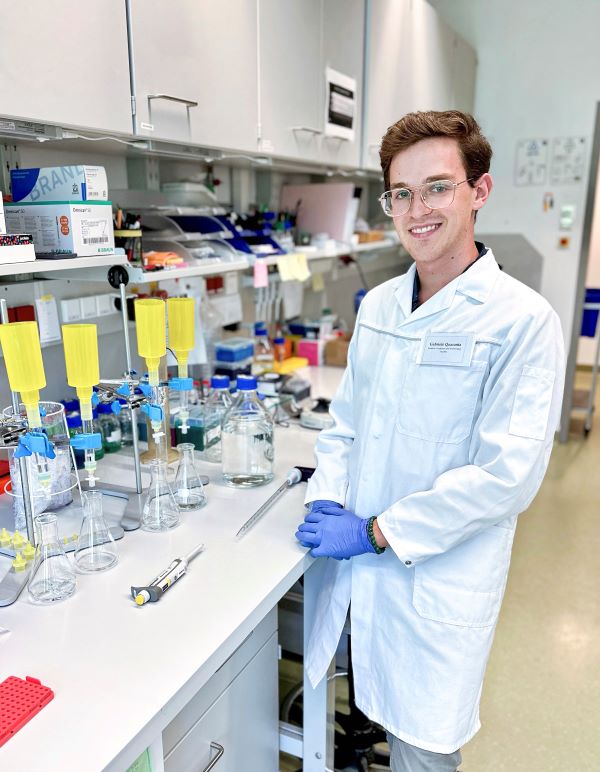February 1, 2024
Finding Your Way in Research
Grow as a researcher with ISTA’s summer program
Despite cold temperatures, the next summer is sure to come. It is the perfect time to put on your lab coat and gain practical experience in the world of science, far away from the stress of exams and lectures. The summer program at the Institute of Science and Technology Austria (ISTA) offers such an opportunity.

Every summer, ISTA opens its doors to bachelor’s and master’s students from all over the world. Between May and September, ambitious young researchers work on exciting research projects as part of the ISTernship program. Over a period of two to three months, ISTerns receive supervision from ISTA’s exceptional faculty. Under their guidance, they acquire hands-on scientific experience and valuable insights for their future endeavors. Finally, the young scientists have the opportunity to present their research work at a poster session in front of colleagues, mentors, and professors.
Three former ISTerns, Siong Chen Meng, Marta Luterek, and Gabriele Quaranta, talk about their experiences and offer tips for a successful application.
Why did you apply for the ISternship?
Siong Chen Meng: During my master’s in biophysics at the University of Cambridge, I have already done a couple of internships in Singapore and the UK. I applied at ISTA to experience the scientific environment of a different country. Additionally, the interdisciplinary nature of the research conducted at ISTA immediately appealed to me.
Marta Luterek: I study biotechnology at the Jagiellonian University in Krakow, Poland, and I applied for the ISTernship program to gain additional hands-on research experience and explore a new field within biochemistry.
Gabriele Quaranta: I’m currently studying biological sciences at the Scuola Normale Superiore of Pisa, Italy, and decided to apply for the ISTernship program because I aimed to gain real research experience during my undergraduate studies. I wanted to get out of my comfort zone and try exploring a new environment. ISTA was the perfect place to find excellent opportunities for research and personal growth.
In which groups did you do your research work?
SCM: At ISTA, I worked in the Palacci group, studying the behavior of artificial swimmers on curved surfaces.
ML: I’ve spent my ISTernship in the Loose group, where I gained insights into the molecular mechanisms that drive intracellular self-organization.
GQ: I was an ISTern at the Novarino Lab and contributed to a project that aims to discover the role of extracellular proteins in autism and neurodevelopmental disorders.

Frequently asked questions:
What insights have you gained during your time at ISTA?
SCM: I learned a lot during my ISTernship, such as how to code in MATLAB—a programming platform—and how to use an optical microscope. However, my most important takeaway was how to present my research. With the help of my supervisors, I was able to craft a presentation that not only told a story but also provided the details needed for others to understand my research. On top of that, I appreciated the diverse and international nature of my fellow ISTerns. It was amazing to learn about their cultures and histories.
ML: I gained a lot of confidence working independently and analyzing data, as I got great supervision from my mentors in the lab. Moreover, I developed my practical skills in multiple techniques, particularly protein purification and TIRF microscopy. I also enjoyed the challenge of preparing a poster at the end of my stay. Most importantly, I met many other ISTerns, with whom I became great friends.
GQ: During my time in the lab, I learned many new techniques and how to design experiments. My amazing supervisors guided me through the whole process, teaching me “the secrets of the job” and allowing me to learn from my mistakes. Thanks to this valuable experience, I’m looking forward to continuing my studies in the field of neuroscience.

Any last-minute advice for future applicants?
SCM: One piece of advice I received that was very useful, is to craft a narrative in your statement of purpose—find the links between your research experiences, the classes you take, and the other science-related activities you have done.
ML: My main piece of advice would be to make sure that you know why you want to participate in the ISTernship and let your statement of purpose reflect that. On another note, I would also encourage opting for housing in Vienna. While the ISTA campus is gorgeous and living there is definitely convenient, personally, I benefited from being close to the city, and I even quite enjoyed my daily commute with the shuttle bus, riding along the Danube on a sunny morning.
GQ: The ISTernship program is a great fit for students who want to have hands-on experience in the scientific field they study, and also for those who want to explore different areas and are undecided on what is the right path for them. It is a highly competitive position, but with a little effort, anyone can write a good application. Don’t use complicated periphrases in your statement of purpose; use your own words about your motivation to work in the lab, and to contribute to your field in the future. In my opinion, honesty and dedication are the keys to a successful application!



